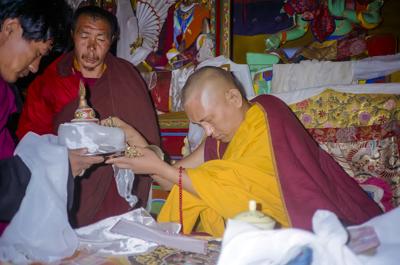Practicing mindfulness, the more we realize the reality of the phenomena, particularly of the I and the aggregates, the sense objects and so forth, the more we are able to see how other sentient beings are suffering, how their life is totally living in the concept of permanence, their hallucinated minds apprehending impermanent phenomena—that are changing within every second by causes and conditions—as permanent.
We all have this wrong concept of permanence, looking at impermanent phenomena as if they are permanent, as if our life and the sense objects in our life, and the surrounding people—friends, enemies and so forth—everything is always going to be like this. We have a fixed concept that things have always been like that and that they are always going to be like that. They’re kind of fixed; they’re going to last. When we are not aware of their nature, if it’s left up to our mind, then we have the concept that things are going to last a long time, it’s always going to be always like that.
I think the electricity in Nepal is a very good teaching, reminding us of impermanence! [Rinpoche and students laugh] When the lights go off, the appearance of many bright objects suddenly stops. It is there but suddenly it’s gone. This is similar to the appearance of this life. Seeing the brightness of the object, seeing around us many people like our friends, places, objects, possessions, pleasures—including this human body we now have—all these appearances that are happening now can be stopped at any time. The appearance of this life can be stopped at any time, like the appearance that happens when we have electricity and the lights are on.
The day that the impermanence of death happens, at that time it is just like last night’s dream. That appearance of this life that was happening is gone. It happened and then it is gone. Like when there is a flash of lightning, during that moment we have the appearance of a brilliant, bright object. We see our own human body and the people around us as well as all the other phenomena—this happens and then it is gone.
It is exactly the same when the day, the hour, the minute that the impermanence of death comes, when death happens. What we feel is just like that. The appearance of this life with all its many brilliant objects that were happening are suddenly stopped, just like the moment after a flash of lightning. During the flash we have this appearance, but we can’t trust it. We can’t assume this bright appearance of objects, people, material, places and so forth, including this human body, will remain. The appearance can be stopped at any time because life can be stopped at any time. The impermanence of death can come any time. Because the actual time of death is uncertain, the appearance of this life we now have can be stopped at any time. That is the nature of life.
When we look at others and ourselves we can see that even though we have met Dharma, we still can’t conquer death, we can’t overcome death. We have not yet gained complete freedom over the rebirth and death like the arhats and the arya bodhisattvas have. The practitioners of the Lesser Vehicle path, the arhats, have completely ceased the cause of the suffering, karma and delusions, including the seed of delusions, ignorance, the concept of inherent existence, and have achieved freedom over death and rebirth caused by karma and delusion. Arya bodhisattvas, the practitioners of the Mahayana, the great vehicle, have actualized the wisdom directly perceiving emptiness and have completely abandoned suffering rebirth, old age, sickness and death; they never have to experience them again.
Then the practitioners of the highest tantra achieve the realization of the completion state, which has six levels—the isolation of body, the isolation of speech, the isolation of mind, the clear light, the illusory body and the unification [of clear light and illusory body]. Those who have achieved the isolation of mind and the clear light are the real yogis; they have the qualification to receive the label “yogi.” These practitioners can achieve enlightenment in this very brief lifetime of these degenerated times. Having achieved clear light, with that realization, they can become enlightened within a few years. According to highest tantra, these are the great yogis. After having achieved clear light, they have overcome the suffering cycle of death and rebirth.
Without practicing tantra, even by practicing the Lesser Vehicle path or the bodhisattva path, the Paramitayana, we are able to overcome death and rebirth. Even if we don’t get to accomplish these levels in this life, where we can be completely free from death and rebirth, by having met the Buddhadharma we can at least make preparation to receive a better rebirth again with a perfect human body, and then we can continue to practice the Dharma, and like this to complete the path to full enlightenment. The reason we do this is for the sake of the numberless sentient beings, to free them from all the sufferings and lead them to peerless happiness, to full enlightenment.
In this case, what is called “death” is just like changing our clothes. We take off our old clothes and put on new ones—this new body with which we can practice Dharma under even better conditions. Even if we don’t get to achieve very high realizations in this life, at least we can accomplish this [better rebirth] by practicing the holy Dharma.































